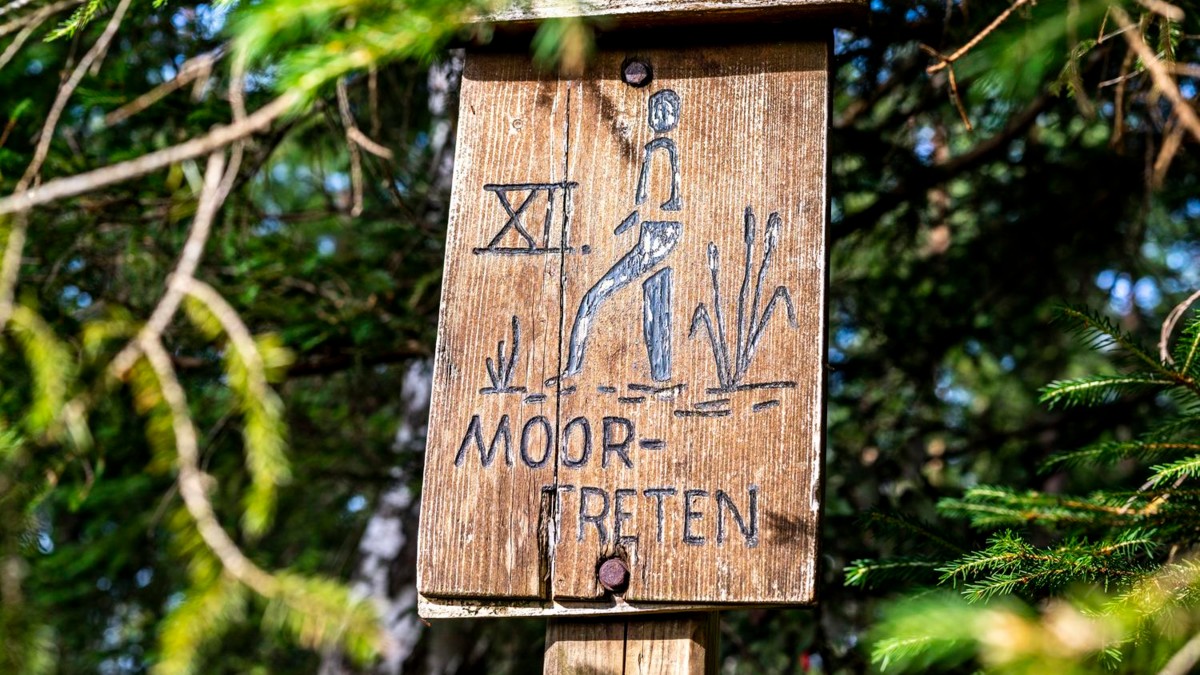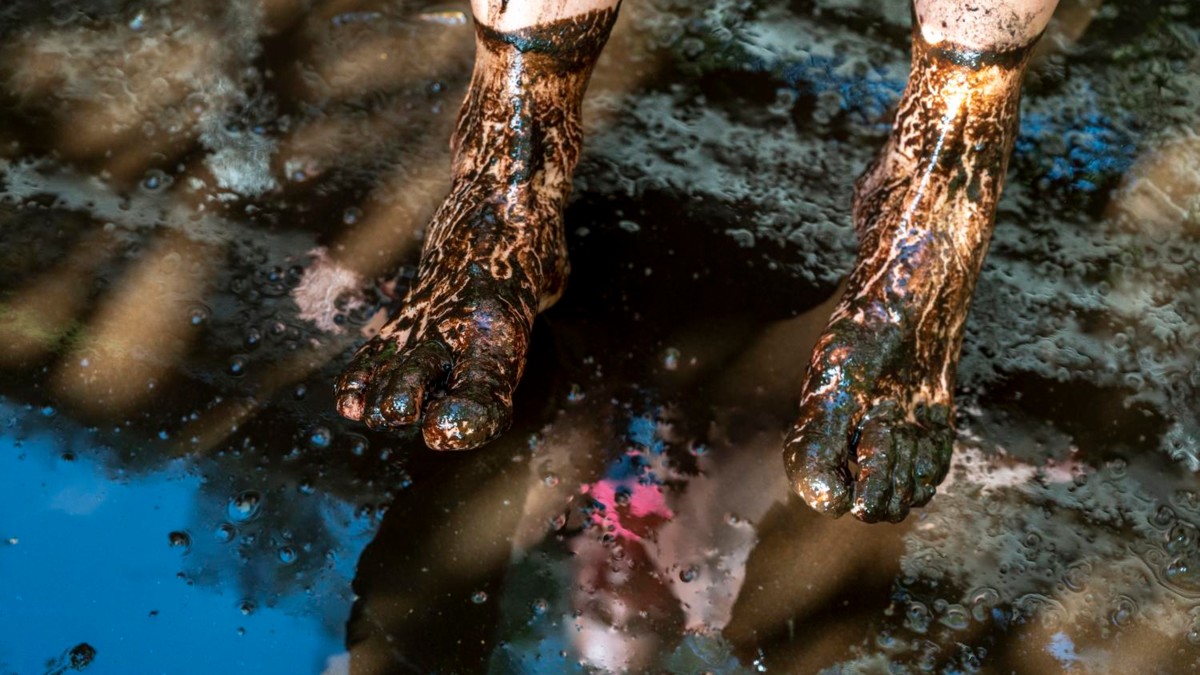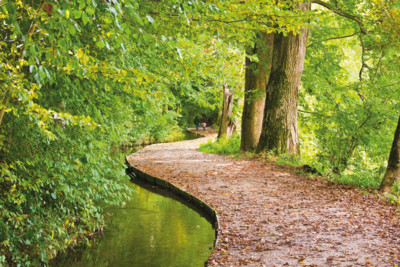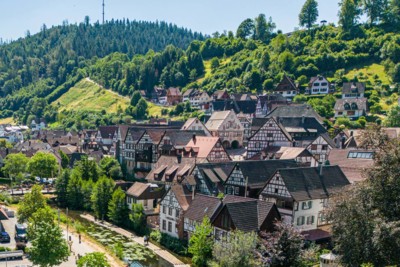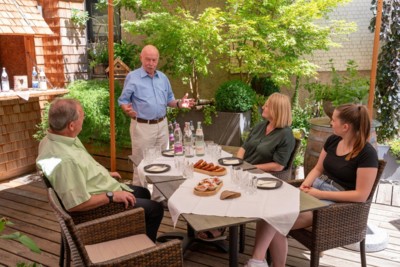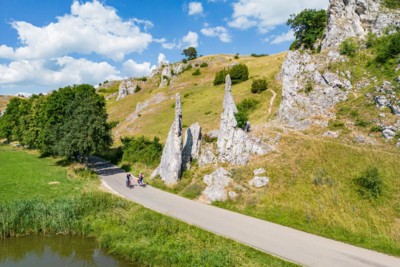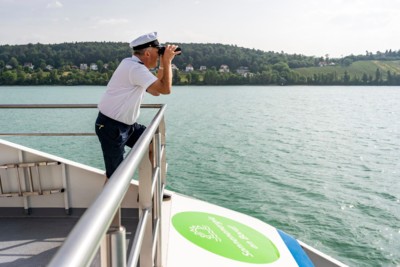Valuable Landscapes
The Moorlands of Upper Swabia
© TMBW, Foto: Gregor Lengler


BW Story - CMR
Discovering the Wurzacher Ried
Unique moors are waiting to be discovered in the southeast of Baden-Württemberg. We went to the Wurzacher Ried (Wurzach Reed) to find out what makes these landscapes so special.
Take off your shoes and just do it: In the Wurzacher Ried in the Upper Swabia-Allgäu Region, there is a rustic moor basin in the middle of the countryside. If you’re brave enough to step in, you won’t be standing in ice-cold, crystal-clear water like you would when taking a Kneipp cure. You’ll stand up to your ankles in mud, sorry, in the moor. It takes a little effort to do it, but it feels pleasantly cool, soft, and soothing to the feet, especially on hot summer days. Afterwards, you can wash off your feet in the stream on the other side off the forest path, making a very pleasant end to your hike through the Wurzacher Ried. The moor here is so valuable it has been designated a European bird and flora and fauna habitat conservation area (‘Natura 2000’).
 Moorlands Are Important CO2 Reservoirs
Moorlands Are Important CO2 Reservoirs
Moors and Their Role in the Fight against Climate Change
Moorlands Are Important CO2 Reservoirs

Moors such as the Wurzacher Ried in Bad Wurzach are valuable natural areas, especially now in the fight against climate change. Not only are they home to many rare animals and plants, they are also the most effective carbon stores of all terrestrial habitats on Earth. Think about it this way: Moorlands store the carbon from plants, the residues of which are then preserved in the form of peat. But unfortunately, the moors of the world are not doing well. And Germany is no different: around 95 per cent of the moorlands have been drained. Dry, destroyed moorlands are therefore also responsible for around 5 per cent of greenhouse gas emissions in Germany. And the situation is even worse in other regions of the world. Reason enough to value the moors and restore them where they have been drained, and to avoid using peat in garden soil.
How Melting Glaciers Create Moors
In Southwest Germany, there are still more than 170 square miles of moorland, making up around 1.3 per cent of the state area. Particularly north of Lake Constance, in the Upper Swabia-Allgäu Region, the melting glaciers in the Würm glaciation around 12,000 years ago left depressions in which meltwater collected and could no longer drain off. Shallow lakes formed, which became into fascinating moors such as the Wurzacher Ried, the Federseemoor and the Pfrunger-Burgweiler Ried. Because of the lack of oxygen in still water, dead plants could not decompose completely and were deposited on the ground as peat - their carbon stored down there.

Why the Haidgau Outlet Lakes Are Crystal-Clear
A guided walk on the moor with Siegfried Roth, head of the local nature conservation centre, starts in the afternoon. He is enthusiastic about this intact upland moor, which is largely fed by rainwater, the unique habitat for rare birds such as cranes, which have been breeding here again for some years. And about the Haidgau Outlet Lakes (Haidgauer Quellseen), which can be looked at from a small wooden platform. They are quite shallow and incredibly clear due to their hard, mineral-rich water. No wonder they are Roth’s favourite place. According to the expert, what makes the Wurzacher Ried so special is that there are so many different types of moor: Spring moors, rainfall-dependent upland moors, and low moors shaped by rivers. Which will be your favourite?
Rare Birds in the Wurzacher Ried
In the past, moors were not only eerie for people because of their often almost mystical atmosphere, they were also simply hostile, dangerous stretches of land. Today, it is not only experts like Siegfried Roth who appreciate these unique landscapes. “I find it fascinating that there are areas in the middle of the Wurzacher Ried where humans have never intervened and where no one can go even now.” Rare birds such as black storks, corncrakes, and spotted crakes migrate through this zone, which makes up about a third of the reed. Water-retaining mosses have colonised the area and the sundew, which compensates for the lack of nitrogen in the moor by attracting and feeding on insects with its sticky leaves.
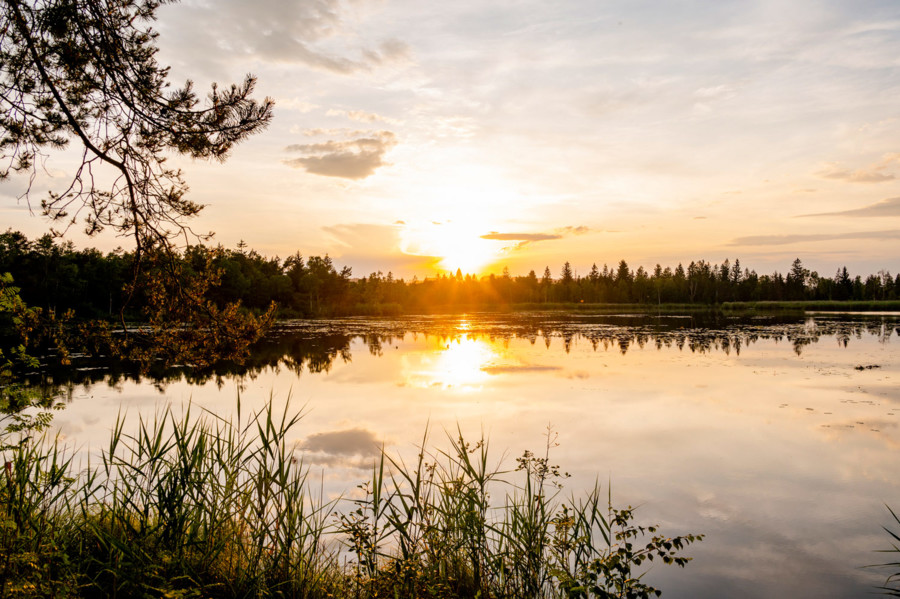
Idyllic Moor
The moor never really lets you go, and it is just as fascinating in the summer without the fog. In the evening at Lake Riedsee in Bad Wurzach, the sun is low in the sky, tinting the clouds pink and casting colourful reflections on the calm lake. A few azure damselflies buzz just above the surface towards the carpet of water lilies, their territory. Two great crested grebes paddle by. Birds chirp. The reeds rustle. Just stand still on the footbridge and say nothing. You are just a spectator here. And it feels great.
Hiking, Bathing, Relaxing
Excursions and Activities in the Moor

Bathing in 40C Hot Peat
It bubbles, gushes, and gurgles when one of the tubs in the ‘feelMOOR’ Spa in Bad Wurzach fills up. The mixture of natural moor and thermal water in the moor spas of Bad Wurzach, Bad Buchau and Bad Waldsee is heated to 40 degrees. As this kind of treatment can affect your circulation, you need a doctor’s certificate before you can enjoy a moor bath. The warm peat substances give the body a kind of artificial fever, have an antibacterial effect and are said to provide relief from back pain, slipped discs and muscle and joint diseases. In any case, these baths are as sweaty as they are relaxing. And the atmosphere in the ‘feelMOOR’ Spa is perfect too. After 20 minutes, you feel like you’re melting away, your body is programmed for deep relaxation, so the best thing to do is spend the rest of the day calm and relaxed, enjoying the wonderful feeling of not having to do anything. After a moor bath, it is best to postpone the walk along the boardwalks to Lake Riedsee and the visit to the ‘MOOR EXTREM’ exhibition in the nature conservation centre in Bad Wurzach for a little.
Wackelwald in Bad Buchau: On Wobbly Legs
Does the ground beneath you bounces when you walk and wobbles when you jump? There is nothing wrong with you, but the Wackelwald, literally wobbling wood, in Bad Buchau is a very special moor phenomenon. It is located right near the Kurpark Garden on the outskirts of Bad Buchau and is open to the public. Because the trees grow on silted moorland, the ground is more elastic than elsewhere. The NABU Wackelwald Trail has eight information stations with everything you need to know about Lake Federsee Moor.

Sunrise at Lake Federsee
Enjoy the silence of the moors. Marvel at the picturesque reflection of dead tree stumps in the water. Listen to the cotton grass swaying gently in the wind. At almost 13 square miles, Like Federsee Moor is the largest moor in Southwest Germany - and because of its unique importance for birdlife, it holds several certificates: it is part of the pan-European Natura 2000 network of protected areas and a European Bird Reserve. The starting point for any visit is the Federsee NABU Nature Conservation Centre, with its ‘Nature at Lake Federsee’ Exhibition. Guided excursion and ornithological walks on the moor start from here, you can watch live images from inside a nesting box or observe Lake Federsee fish in the aquarium. You can also explore the unspoilt nature here on your own on the Federsee Footbridge, which starts at the Federsee Car Park and leads you over 1.5 kilometres into the moorland on dry feet - an unforgettable experience, especially early in the morning at sunrise.
Hiking in the Moor
More than 200 different bird species live in the Pfrunger-Burgweiler Ried further east. The nature conservation in Wilhelmsdorf offers an interactive journey through the second-largest moorland area in Southwest Germany. It is also the perfect starting point for hikes and cycling tours. Our tip: Try the Moorseenrunde Trail. It is only 6.6 kilometres long and offers plenty of lovely views over the water. Or enjoy the view from the Pfrunger-Burgweiler Ried Bannwald Tower in Ostrach.
 5 Things Not to Do on the Moor
5 Things Not to Do on the Moor
5 Things Not to Do on the Moor
- Leaving the trails – it could be dangerous and is also disturbing the flora and fauna.
- Making noise – there are animals that are sensitive to noise.
- Leaving litter behind – pretty obvious.
- Picking or taking plants or take them home – we are only guests on the moor.
- Forgetting the mosquito repellent in the evening.
Overview
More on the Moorlands of Upper Swabia
 You Might Also Be Interested In
You Might Also Be Interested In
Want to Browse More?
You Might Also Be Interested In


